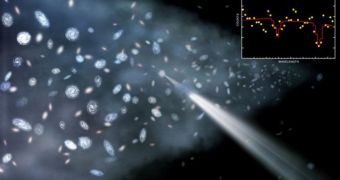One of the main things that puzzled experts about existing cosmological models was the fact that there did not seem to be sufficient amounts of normal matter in the nearby Universe. That is to say, theoretical predictions were tested on very distant galaxies, but, when physicists tried to apply them to our “neighborhood,” they could not find sufficient amounts of matter. This concept is not the same as dark matter, researchers are quick to point out. The stuff they were looking for is made of protons and electrons, organized in particles called baryons. Recently, they found an impressive chunk of it.
Protons and electrons are the atomic components that make up most ordinary matter. However, their combined mass only accounts for a small portion of the entire amount of matter in the Universe, with the vast majority of it remaining undetectable (dark matter). But observations could not even reveal the existence of the predicted amounts of regular matter, and astronomers were very curious as to what may have happened to it. Some theories suggested that this missing matter may be concealed inside the enormous webs of hot and diffuse gas that permeate the Universe, but thus far there has been little evidence to support these ideas.
All that changed recently, when combined observations from the NASA Chandra X-ray Observatory, and the European Space Agency's (ESA) XMM-Newton satellite revealed an impressive chunk of missing matter. The mass was found to be hiding about 400 million light-years away from our planet, inside a wall-shaped structure of galaxies. The discovery lends additional credence to researchers suggesting that most of the missing matter is located in the so-called Warm-Hot Intergalactic Medium (WHIM). According to some, the medium itself is made up of materials that did not make it into galaxies, and also from matter that was expelled from galaxies over billions of years.
“Evidence for the WHIM is really difficult to find because this stuff is so diffuse and easy to see right through. This differs from many areas of astronomy where we struggle to see through obscuring material,” says University of California in Irvine (UCI) professor Taotao Fang, who was also the lead author of the new investigation. Details of the study appear in the May 10th issue of the esteemed Astrophysical Journal, Space reports.
“Having good detections of the WHIM with two different telescopes is really a big deal. This gives us a lot of confidence that we have truly found this missing matter,” adds UCI expert and study coauthor David Buote. The missing matter was found in the Sculptor Wall of galaxies.

 14 DAY TRIAL //
14 DAY TRIAL //